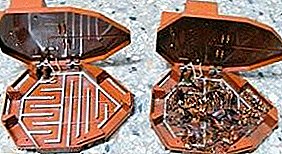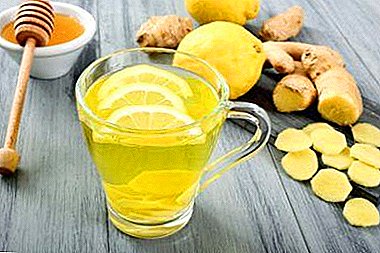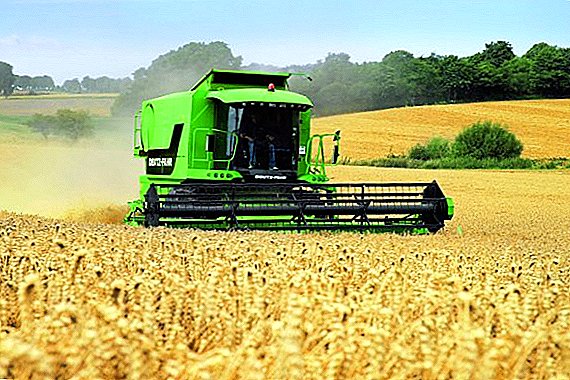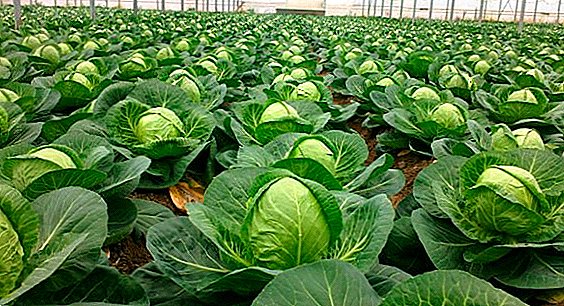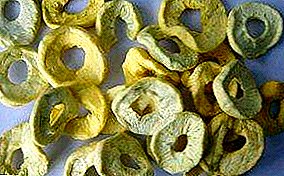 Farmers often prefer to buy small calves in order to independently grow from them a strong and strong animal, while being confident in the naturalness of its food. This is important both when breeding calves for meat, and when raising dairy cows, especially for their own consumption of products. In order to achieve the goal as much as possible, it is important to choose the right breed of animal and its representative, which can be quite a difficult task for a novice farmer. Let's find out how to choose the right representative of the dairy and meat areas, having considered the features of different breeds in the article.
Farmers often prefer to buy small calves in order to independently grow from them a strong and strong animal, while being confident in the naturalness of its food. This is important both when breeding calves for meat, and when raising dairy cows, especially for their own consumption of products. In order to achieve the goal as much as possible, it is important to choose the right breed of animal and its representative, which can be quite a difficult task for a novice farmer. Let's find out how to choose the right representative of the dairy and meat areas, having considered the features of different breeds in the article.
Purpose of purchase
The main goals of buying a calf are only two: either they will later be handed over for meat, and here we are talking about bull calves, or will be left for the sake of further milk production, and then it is necessary to purchase a little chick.
Important! All numerical values are averaged, and more accurate indicators of weight gain will depend on the conditions and nutrition of animals.
In both cases, there are quite a few breeds that can satisfy any of these breeder needs. Consider the most popular ones. 
Bullhead for fattening (slaughter for meat)
Usually, when growing a bull for meat, a farmer is interested in maximum daily weight gain, so that by 1-1.5 years it is possible to hand over the animal for slaughter and get the maximum profit.
Learn about the most famous types of meat bulls and about the features of growing bulls for fattening.
Most of the representatives of meat breeds with intensive fattening are able to gain 400-500 kg by this time, although sometimes there are more modest figures of 350 kg. The average indicators for breeds are presented in the table below.
| Breed | Weight at birth (kg) | Daily weight gain of calves (g) | Weight at the age of one and a half years (kg) |
| Aberdeen-Angus | 25 | 800 | 350 |
| Kazakh Whitehead | 27 | 1000 | 400-450 |
| Hereford | 36 | 1200-1500 | 350-400 |
| Simmental | 44-46 | 900-110 | 350-400 |
| Sharolezskaya | more than 30 | 1000-1500 | 400 |
| Shorthorn | 35 | 1200-1500 | 450-500 |
| Golshtinsky | 45 | 900-1100 | 450 |
| Limousin | 35 | 1000 | 500 |
| Kalmyk | 30 | 1000 | 450-550 |

Girl on the cow
It is also not too easy to choose a little girl for further cultivation in order to get milk. Breeding individuals are not cheap, and you still need to understand which breed to prefer, having considered their main features and requirements. Good dairy breeds for our locality are shown in the table below.
| Breed | Milk yield per year (t) | Milk fat content (%) | Protein content (%) |
| Black and motley | 5,0 | 3,7-3,9 | 3,2 |
| Red-motley | 4,15 | 3,96 | 3,4-3,7 |
| Red steppe | 3,2-3,5 | 3,5-4,0 | 3,7-3,9 |
| Ayrshire | 8,5 | 4,28 | 3,44 |
| Dutch | 4,5 | 3,5-4 | 3-3,5 |
| Yaroslavskaya | 2,7-3,5 | 4,4-4,5 | 3,4-3,7 |
| Jersey | 3,0-3,5 | 5-6 | 4 |
| Kholmgorskaya | 3,5-4,0 | 3,6-3,7 | 3,3-3,4 |
 Of course, each breed has its own advantages, but when making the final choice, it is worthwhile to focus on other breed characteristics of the calf: demands on the conditions of detention and feeding, immunity and early ripening of immunity.
Of course, each breed has its own advantages, but when making the final choice, it is worthwhile to focus on other breed characteristics of the calf: demands on the conditions of detention and feeding, immunity and early ripening of immunity.Usually, high-dairy cows require proper attention from the owner.
How to choose a calf when buying
There are a number of criteria that should be guided when buying a small cow or bull, starting from the characteristics of appearance and age. The buyer should also take into account the calf's pedigree and pay attention to his sucking reflex and breathing.
Age
The ideal age for buying bulls for fattening is 1.5-2 months from birth, when you can already assess his health. At an earlier age, babies are still weak and can get sick in new conditions.
In order not to be mistaken in the age of the calf when buying, always pay attention to the following factors:
- The presence of the umbilical cord: if it is and hangs - the calf is not more than 10 days, however, among representatives of the Holstein breed, it can only fall away at the age of twenty.
- The condition of the teeth of the selected animal: The kid has 4 milk teeth since birth, after a week he has the third and fourth pair of incisors, and another 7 days later the third pair of molar molars grows (unlike regular ones, milk samples are always much thinner and softer). The incisors reach their full development in 3-4 months, and at 4-5 months of age, the hooks and the inner side of the middle teeth begin to grind, and the first permanent posterior molars appear.

Appearance
The appearance of the calf is able to characterize his condition is much better than the owner. If the selected animal is active, fun and curious, and the wool on it is beautifully shimmering - this is a suitable option for the purchase.
Important! Sometimes, in order to hide the calf’s present age or to transport it more safely, vendors can cut the umbilical cord, which will be noticeable externally.
Sometimes healthy calves even approach themselves to humans, while the weak and sick continue to lie without showing any activity at all.
If you do not want to spend extra strength and money on nursing weak calves, then you should avoid animals with:
- hunchbacked back;
- lowered ears;
- teary eyes;
- discharge from the nose.
In addition, always buy the calf's navel before buying. In healthy animals, it should not have swelling or cause any inconvenience to the baby - if the animal experiences discomfort during palpation, it will surely start to kick, or at least try to distance itself from you.  Disease of the navel always requires treatment, otherwise the existing infection can lead to accumulation of pus in the abdominal cavity and subsequent death of the calf.
Disease of the navel always requires treatment, otherwise the existing infection can lead to accumulation of pus in the abdominal cavity and subsequent death of the calf.
Did you know? Cows are able to feel sadness and cry, just like people. So, if an individual takes a newborn calf, it can cry continuously for several hours.
Calves with a large navel deserve special attention (at birth more than 18 mm at the base). In 90% of cases, they have an innate susceptibility to various diseases. At the same time, the presence of an umbilical hernia can cause growth retardation of the animal, which is why the cost of such calves is always lower.
You can check for a hernia by pushing the navel protrusion inward. If at the same time it is possible to grope through the hole, it means that the baby has a hernia.
Calf breathing
During the inspection, be sure to pay attention to the nature of breathing individuals. Rapid inhalation and exhalation (more than 20 times per minute) indicate possible violations of the respiratory system. To check your lungs, get the calf to run around the farm for a few minutes: if it starts coughing, then there are still problems.  You can check for cough by assessing the condition of the tracheal ring: feel the respiratory trachea (located at the base of the neck) with your fingers, and then gently press it and pull it down (click).
You can check for cough by assessing the condition of the tracheal ring: feel the respiratory trachea (located at the base of the neck) with your fingers, and then gently press it and pull it down (click).
If the baby began to cough and wheezing is heard, this indicates a disease of the respiratory system. To the touch, the trachea resembles a round tube and can even slip out of the fingers.
Sucking reflex
Checking the calf's sucking reflex is another good way to make sure he is healthy. Put the baby two fingers in your mouth and see how actively he will begin to suck them: if all movements are brisk and the temperature in the mouth is not too high, then such an individual can be bought.
Calves aged 1 to 3 months do not bite, so do not be afraid of this.
Did you know? If you do not take a calf from a cow, she can feed him with her milk for three years.
Pedigree
In most small private farms, it is not necessary to rely on reliable data regarding the pedigree of the selected animal, because even if there are documents, they are not always correlated with reality.  However, if we are talking about a proven farm with a good reputation, then you should pay attention to the following important points:
However, if we are talking about a proven farm with a good reputation, then you should pay attention to the following important points:
- mother's productivity (if the cow’s milk yield corresponds to 5500 liters per year, and the same indicator of cows on the father’s line exceeds 8500 liters, then in any case the selected baby will be able to produce only 500 l more than the mother’s);
- maternal and paternal lines over several generations should not intersect (avoid inbreeding, because the kinship of the parents badly affects the health of their offspring).
Adhering to such simple recommendations, you can always choose a good calf of any breed. However, how he grows depends on your continued care and nutrition, which you should not forget about.


